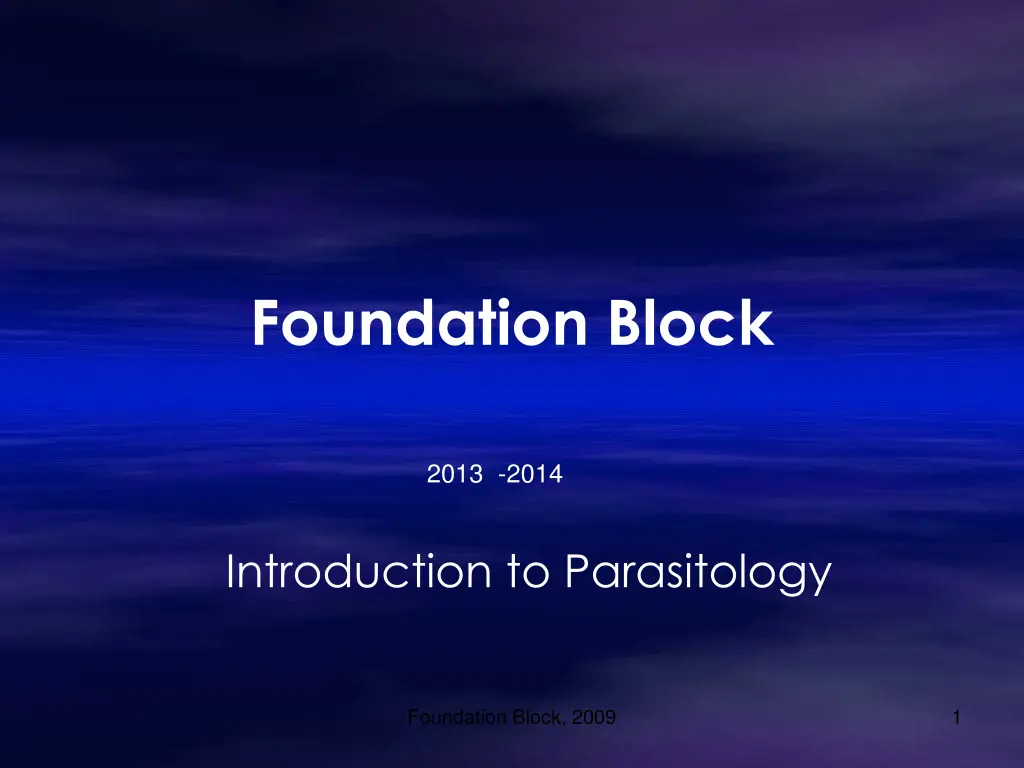
Introduction to Parasitology: Definitions, Hosts, and Classifications
Explore the definitions of infection, hosts, and parasites in parasitology. Learn about different types of hosts, such as definitive and intermediate hosts, and the classification of parasites including protozoa and helminths. Understand concepts like parasitism, commensalism, and zoonosis. Dive into the scientific names and characteristics of various parasites.
Uploaded on | 2 Views
Download Presentation

Please find below an Image/Link to download the presentation.
The content on the website is provided AS IS for your information and personal use only. It may not be sold, licensed, or shared on other websites without obtaining consent from the author. If you encounter any issues during the download, it is possible that the publisher has removed the file from their server.
You are allowed to download the files provided on this website for personal or commercial use, subject to the condition that they are used lawfully. All files are the property of their respective owners.
The content on the website is provided AS IS for your information and personal use only. It may not be sold, licensed, or shared on other websites without obtaining consent from the author.
E N D
Presentation Transcript
Foundation Block 2013 -2014 Introduction to Parasitology Foundation Block, 2009 1
DEFINITIONS Infection: The entry , development and multiplication of an infectious agent in the body of humans or animals. The result may be: inapparent ( asymptomatic) infection, or manifest (symptomatic) infection.. 2 Foundation Block, 2012
DEFINITIONS Host: A human or animal which harbors an infectious agent under natural conditions . Definitive host (primary host): - A host in which the parasite passes its sexual stage. Intermediate host (secondary host): A host in which the parasite passes itslarvalor asexual stages. Foundation Block, 2012 3
DEFINITIONS carrier: A person or animal that harbors a specific infectious agent in the absence of symptoms and signs of a disease and serves as a potential source of infection pathogenesis: Production and development of disease. pathogenicity: Capability of an infectious agent to cause disease in a susceptible host. . Foundation Block, 2012 4
DEFINITIONS Parasitism: A relationship in which an organism (the infectious agent, the parasite) benefits from the association with another organism (the host) whereas the host is harmed in some way. commensalism: Kind of relationship in which one organism , the commensall , is benefited whereas the other organism , the host , is not harmed or even helped by the association. Foundation Block, 2012 5
DEFINITIONS Ectoparasite: parasite that lives on the outer surface of its host. Endoparasite: Parasite that lives inside its host. zoonosis: Disease of animals that is transmissible to humans . Foundation Block, 2012 6
Scientific names of parasites follow Zoological Classification 7 Foundation Block, 2012
CLASSIFICATION OF PARASITES PROTOZOA HELMINTHS Unicellular Single cell for all functions 1:Amoebae: move by pseudopodia. 2:Flagellates: move by flagella. 3:Ciliates: move by cilia 4:Apicomplexa(Sporozoa) tissue parasites Multicellular Specialized cells Round worms (Nematodes): - elongated, cylindrical, unsegmented. Flat worms : - Trematodes: leaf-like, unsegmented. - Cestodes: tape-like, segmented. Foundation Block ,2012 8
flagella pseudopodia cilia Foundation Block, 2009 9
Trematodes Cestodes Foundation Block, 2009 Nematodes 10
Parasitic Protozoa Blood and tissues Intestinal Foundation Block, 2012 11
Examples of Diseases caused by Intestinal Protozoa Parasite Disease giardiasis Giardia lamblia Entamoebahistolytica amoebiasis Foundation Block, 2012 12
Giardia trophozoite diagnostic stage Giardia cyst ( infective stage &diagnostic stage) Foundation Block, 2009 13
Giadria lamblia an example of Intestinal Protozoa Foundation Block, 2012 14
Giardia trophozoite Giardia cyst ( infective stage) Foundation Block, 2012 15
Giardia lamblia : Life cycle Foundation Block, 2012 16
1-. Giardia cysts are the infective stage of G. intestinalis. As few as 10 cysts can cause infection , These cysts are ingested by consuming contaminated food or water, or fecal-orally. They can survive outside the body for several months, and are also relatively resistant to chlorination, UV exposure and freezing. 2_. When cysts are ingested, the low pH of the stomach acid produces excystation, in which the activated flagella breaks through the cyst wall. This occurs in the small intestine, specifically the duodenum. Excystation releases trophozoites, with each cyst producing two trophozoites. 3. Within the small intestine, the trophozoites reproduce asexually (longitudinal binary fission) and either float free or are attached to the mucosa of the lumen. 4. Some trophozoites then encyst in the small intestine, Both cysts and trophozoites are then passed in the feces, but only the cyst is infectious , Person-to-person transmission is possible, Animals can also be infected with Giardia . Foundation Block, 2009 17
Examples of Diseases caused by Blood and Tissue Protozoa Parasite Disease malaria Plasmodium spp Foundation Block, 2011 18
Malaria Species Four main species of malaria : Plasmodium falciparum Plasmodium vivax Plasmodium ovale Plasmodium malariae Foundation Block, 2011 19
LIFE CYCLE OF MALARIA Oocyst Sporozoites Stomach Wall Zygote Salivary Gland sporozoites Pre-erythrocytic (hepatic) cycle Gametocytes Exo-erythrocytic (hepatic) cycle Erythrocytic Cycle Hypnozoites Foundation Block, 2012 20
Main pathology of malaria is due to invasion of the RBCs Foundation Block, 2012 21
Examples of Diseases caused by Blood and Tissue Protozoa Parasite Disease Leishmania major Cutaneous leishmaniasis Foundation Block, 2011 22
Cutaneous leishmaniasis caused by Leishmania major Foundation Block, 2012 23
OBJECTIVES By the end of this lecture the student should be able to: 1. Define common terms describing host-parasite relationship. 2. Outline the broad classification of parasites. 3. Name examples of protozoan parasites. 4. Describe the life-cycle of Giadia lamblia as an example of intestinal protozoa. 5. Describe the main stages of the life-cycle of Plasmodium as an example of blood and tissue protozoa. 26 Foundation Block, 2012
Resources on Parasitology Foundation Block, 2012 27
Resources on Parasitology Centre for Disease Control and Prevention (CDC) : http://www.dpd.cdc.gov/DPDx/HTML/Para_Health.htm Foundation Block, 2012 28






















